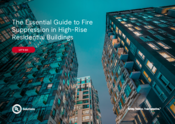
Guide to Fire Suppression in High-Rise Residential Buildings
This complimentary e-book explores the post-Grenfell Tower regulatory changes, the impact of auditing and evaluating fire-suppression systems, and examples of successful retrofitting programs.

In the U.K., fixed fire suppression systems are common in newbuild high-rise residential buildings. But what about older buildings? How are building refurbishment programs addressing the installation and maintenance of these life-saving fire suppression systems?
In our complimentary e-book, “The Essential Guide to Fire Suppression in High-Rise Residential Buildings,” UL Solutions provides a review of topics highly relevant to housing providers and the fire-suppression industry, including:
In England, Post-Grenfell requirements such as the Building Safety Act 2022 and Higher-Risk Buildings Regulations 2023 have come online, overseen by Building Safety Regulator. Other parts of the U.K. have enacted different regulations that address unique needs and vulnerabilities in residential stock. Plus, learn about standards that cover residential sprinklers.
While high-rises are outfitted with passive fire protection, fine-mist water sprinklers provide an effective, instant water supply. A recent study found that just 18.9% of social housing in England had been fitted with sprinklers. But while no new regulations require automatic fire suppression systems in existing high-rise buildings, the Building Safety Act does require risk assessments.
Social-housing providers across England are assessing and auditing high-rise and low-rise stock, as required by recent regulations. Recent reports from the U.K.’s Regulator of Social Housing identified serious safety issues that may result in fatalities during a fire event. Learn how these providers have systemically added more modern passive firestopping technology as well as effective sprinkler systems.
The Grenfell Tower tragedy compounded the everyday worries of high-rise residents regarding fire emergencies. However, some housing providers made swift and visible updates to their properties, which include high- and mid-rise buildings, complex blocks, individual homes — including historically significant properties. When changes are communicated well and performed properly, fire suppression efforts help residents sleep better at night.
In the U.K., there’s less awareness regarding the need to regularly maintain and test fire suppression systems. For sprinkler and water mist systems, the FPA recommends annual inspections. However, these inspections should not be conducted by building owners, maintenance staff, system manufacturers or installers. Instead, the FPA recommends that independent, third-party providers should provide this critical service to maintain impartiality. Every 25 years, a sample of sprinklers should be removed and tested by an independent testing laboratory.
We have been certifying and listing fire sprinklers since 1902. Our certification and testing services help manufacturers of fire suppression systems demonstrate compliance with applicable standards, such as EN 12259-14. Our laboratories are also well-equipped to test sprinklers sampled from field installations. Additionally, our product database, UL Product iQ®, allows for quick location of certified fire-safety products and components that support safer conditions in residential buildings.

Guide to Fire Suppression in High-Rise Residential Buildings
Thanks for your interest in UL's products and services. Let's collect some information so we can connect you with the right person.